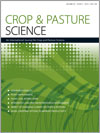CP15198Genotypic stability of weed competitive ability for bread wheat (Triticum aestivum) genotypes in multiple environments
Crop competition is an important component of weed management in modern cropping systems. A large number of wheat genotypes varying in early vigour were evaluated over multiple sites and seasons to identify differences and stability of competitive ability. Several of these experimental high vigour lines showed consistently greater weed suppression than commercial cultivars. A strong association between genotype mean weed suppression and stability across four environments provides evidence for opportunities in the selection of improved weed competitive ability in wheat.




